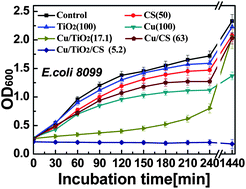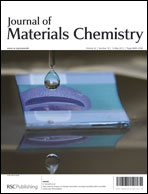Facile preparation and synergistic antibacterial effect of three-component Cu/TiO2/CS nanoparticles
Abstract
Due to the outbreaks of infectious diseases caused by different pathogenic bacteria and development of antibiotic resistance, researchers are actively searching for new antibacterial agents. Synergistic antibacterial effects provide a new way to prepare antibacterial systems to fight resistant bacteria. In this study, novel copper (Cu)/titanium dioxide (TiO2)/chitosan (CS) (CTC) three-component nanoparticles were facilely prepared via photocatalytic reduction on the basis of the synergistic antibacterial principle. The structure, antibacterial activity and antibacterial mechanism of CTC were investigated systematically. The results showed that this hybrid material exhibits excellent antibacterial ability against Escherichia coli and Staphylococcus aureus due to the synergistic antibacterial effect of the Cu, TiO2 and CS components in the nanoparticles. The minimal inhibition concentrations (MIC) of CTC against E. coli and S. aureus are only 5.22 μg mL−1 and 2.61 μg mL−1, respectively, much lower than the two-component systems. Thus, the encouraging results presented in this study demonstrate great potential applications of CTC as an alternative candidate for an antibacterial agent with high antibacterial activity.


 Please wait while we load your content...
Please wait while we load your content...